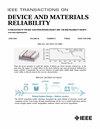Cryogenic Total Ionizing Dose Effects and Annealing Behaviors of SiGe HBTs
IF 2.3
3区 工程技术
Q2 ENGINEERING, ELECTRICAL & ELECTRONIC
IEEE Transactions on Device and Materials Reliability
Pub Date : 2025-01-01
DOI:10.1109/TDMR.2024.3523303
引用次数: 0
Abstract
The total ionizing dose (TID) responses ofSiGe HBTs的低温总电离剂量效应和退火行为
用10 keV x射线研究了液氮温度(78 K)下$0.35~\mu $ m和$0.13~\mu $ m SiGe HBTs的总电离剂量(TID)响应。我们首次比较了78 K和297 K下SiGe HBTs的退火行为,结果再次证实了SiGe HBTs在Mrad(Si)水平下具有优越的TID耐受性,并且78 K下的电流增益衰减远小于297 K下的。然而,在78 K下辐照的$0.35~\mu $ m SiGe HBTs在室温退火(RTA)后,由于氧化物电荷迁移的热激活和界面陷阱的长期积累,表现出进一步的降解。78 K下辐照的$0.13~\mu $ m SiGe HBTs在RTA后变化不大,这可归因于界面陷阱产生和退火之间的竞争。
本文章由计算机程序翻译,如有差异,请以英文原文为准。
求助全文
约1分钟内获得全文
求助全文
来源期刊

IEEE Transactions on Device and Materials Reliability
工程技术-工程:电子与电气
CiteScore
4.80
自引率
5.00%
发文量
71
审稿时长
6-12 weeks
期刊介绍:
The scope of the publication includes, but is not limited to Reliability of: Devices, Materials, Processes, Interfaces, Integrated Microsystems (including MEMS & Sensors), Transistors, Technology (CMOS, BiCMOS, etc.), Integrated Circuits (IC, SSI, MSI, LSI, ULSI, ELSI, etc.), Thin Film Transistor Applications. The measurement and understanding of the reliability of such entities at each phase, from the concept stage through research and development and into manufacturing scale-up, provides the overall database on the reliability of the devices, materials, processes, package and other necessities for the successful introduction of a product to market. This reliability database is the foundation for a quality product, which meets customer expectation. A product so developed has high reliability. High quality will be achieved because product weaknesses will have been found (root cause analysis) and designed out of the final product. This process of ever increasing reliability and quality will result in a superior product. In the end, reliability and quality are not one thing; but in a sense everything, which can be or has to be done to guarantee that the product successfully performs in the field under customer conditions. Our goal is to capture these advances. An additional objective is to focus cross fertilized communication in the state of the art of reliability of electronic materials and devices and provide fundamental understanding of basic phenomena that affect reliability. In addition, the publication is a forum for interdisciplinary studies on reliability. An overall goal is to provide leading edge/state of the art information, which is critically relevant to the creation of reliable products.
 求助内容:
求助内容: 应助结果提醒方式:
应助结果提醒方式:


